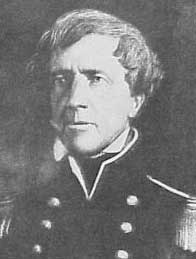Stephen W. Kearny
|
|
Stephen Watts Kearny (August 30, 1794–October 31, 1848) was a United States Army officer, noted for action in the southwest during the Mexican American War, in particular in the conquest of California. He was renowned in his lifetime as the "Father of the U.S. Cavalry".
Biography
Kearny was born in Newark, New Jersey. His family had come from Ireland, where they had been named "O'Kearny". Kearny attended public schools and began studies at Columbia College in 1811, leaving school after two years at the outbreak of the War of 1812 to join the Army. During the war he was cited for bravery and promoted to Captain. He was also imprisoned briefly during the war.
Immediately following the war he was assigned to the western frontier under the command of Gen. Henry Atkinson, In 1819, he was a member of the Atkinson expedition to explore the Yellowstone River in present-day Montana and Wyoming. The 1819 expedition reached only as far as present-day Nebraska, where it founded Cantonment Missouri (later Fort Atkinson). He was also on a follow-up expedition in 1825 that reached the mouth of the Yellowstone. During his travels with the Army, he kept extensive journals of the route, and of his interactions with Native Americans.
In 1826, he was appointed as the first commander of the new Jefferson Barracks in Missouri. While stationed at the barracks, he was often invited to nearby Missouri as a guest of William Clark of the Lewis and Clark Expedition. It was there that he met Clark's stepdaughter, whom he later married. They eventually had eleven children, although not all survived to adulthood.
While at the barracks, he organized a unit of dragoons along the lines of a cavalry outfit. It is from this first unit that the U.S. Cavalry eventually grew, earning him his nickname. The unit was stationed at Fort Leavenworth in present-day Kansas, and Kearny was promoted to the rank of Colonel. He was also appointed commander of the Army's Third Military Department, charged with protecting the frontier and preserving peace among the various tribes of Native Americans on the Great Plains. By the early 1840s, when emigrants began traveling along the Oregon Trail through his command area, he often ordered his men to escort emigrants on the trail across the plains so they could avoid attacks from Native Americans. The practice of military escort of wagon trains would grow into official government policy in the following decades. As part of the effort to protect emigrants, Kearny established a new post along Table Creek near present-day Nebraska City, Nebraska, at a spot Kearny had explored on his earlier Yellowstone expeditions. The outpost acquired the name "Fort Kearny". The Army realized the spot was not well-chosen, however, and the outpost was moved to the present location of Fort Kearny along the Platte River in central Nebraska.
At the outset of the Mexican American War, Kearny proceeded to Santa Fe, New Mexico at the head of a force of 1,700, taking control of the area and becoming its military governor on August 18, 1846. He ensured that a civilian government was in place there by the end of one month.
With his mission in Santa Fe complete, Kearny set out for California on September 25 with a much smaller unit (about 100 men). This group, after having suffered significant attrition during the march, were fought to a standstill at the Battle of San Pasqual.
The surviving force was able to unite with naval reinforcements who had landed in San Diego, under the command of Commodore Robert F. Stockton. This combined force consolidated control of San Diego in December, and in January of 1847 also took San Gabriel and Los Angeles.
Kearny, as ranking Army officer, asserted the right to be in command of the area at the end of hostilities, beginning a rivalry with Stockton. When Mexican forces in the area capitulated on January 13, however, they did so to neither Stockton nor Kearny, but rather to Lt. Col. John C. Frémont. Stockton seized upon this and appointed Frémont military governor of the area. Kearny appealed to Washington, and upon receiving confirmation of his authority took command, having Frémont relieved and arrested (he was later convicted at court-martial).
Kearny remained military governor of California through August, at which point he returned east to Fort Leavenworth, Kansas and later proceeded to Mexico, where he was appointed governor of Veracruz and later of Mexico City. He was promoted to major general In September 1848, over the heated opposition of Senator Thomas Hart Benton (Frémont's father-in-law), but died in St. Louis, Missouri the following month as a result of a tropical disease he had contracted while in Veracruz.
Kearny is the namesake (via misspelling) of Kearney, Nebraska. Kearny, a major street in downtown San Francisco is also named for him.
External link
- General Stephen Watts Kearny (http://rip.physics.unk.edu/Kearney/SWK.html)

